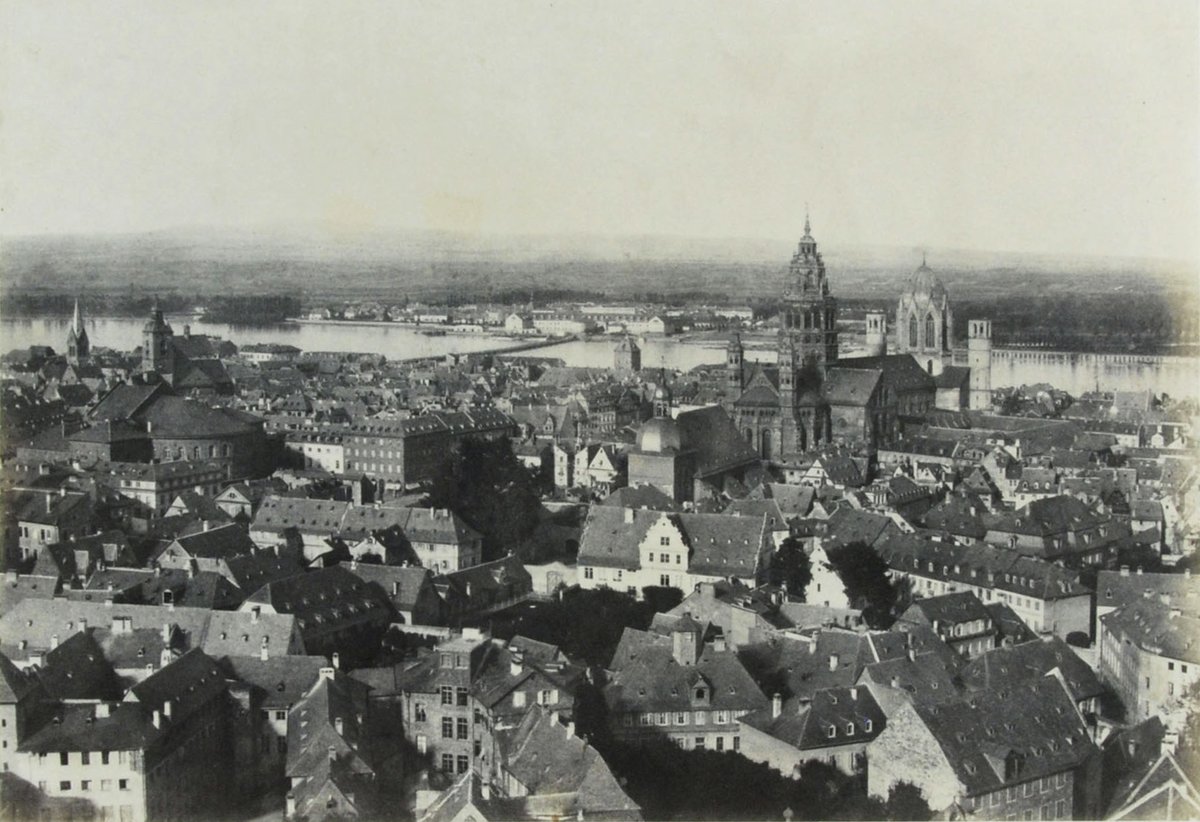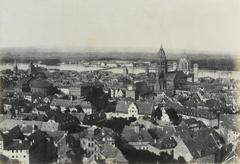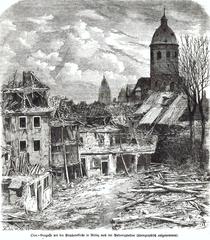
Mainz-Altstadt Visiting Hours, Tickets, and Historical Sites Guide
Date: 14/06/2025
Introduction to Mainz-Altstadt
Nestled at the confluence of the Rhine and Main rivers, Mainz-Altstadt is the historic centerpiece of Mainz, Germany. This vibrant old town invites visitors on a journey spanning over two millennia, from its origins as the Roman fortress Mogontiacum around 13 BCE to its role as a medieval ecclesiastical power center. The area is home to an extraordinary variety of cultural, architectural, and historical treasures, including ancient Roman ruins, medieval cathedrals, and lively wine taverns. Mainz-Altstadt is also intrinsically linked with Johannes Gutenberg and his revolutionary invention—the movable-type printing press—celebrated at the Gutenberg Museum. Festivals such as Mainzer Fastnacht and Johannisnacht, along with scenic promenades and bustling markets, ensure that history and contemporary culture blend seamlessly in this captivating district. This guide provides comprehensive information on visiting hours, ticketing, accessibility, guided tours, and insider tips to help you make the most of your visit (mainz.de; Europe Up Close; mainz-tourismus.com; germansights.com).
Table of Contents
- Introduction to Mainz-Altstadt
- Roman Foundations and Early Growth
- Medieval Power and Ecclesiastical Influence
- Renaissance and Baroque Flourishing
- Turbulence, War, and Modern Renewal
- Architectural Heritage and Key Sights
- Visiting Tips and Nearby Attractions
- Top Historical Sites: Hours and Tickets
- Culinary Highlights and Wine Culture
- Events and Local Traditions
- Accessibility, Transportation, and Guided Tours
- Accommodation Suggestions
- FAQs
- Summary and Visit Tips
- References
Roman Foundations and Early Growth
Mainz-Altstadt’s story begins as the Roman military camp Mogontiacum, founded circa 13/12 BCE. Strategically located for defense and trade, it evolved into the capital of Germania Superior, hosting Roman legions and robust infrastructure—remnants of which, like the Drususstein cenotaph and Roman theatre, can still be visited today (mainz.de; Europe Up Close).
Medieval Power and Ecclesiastical Influence
With the decline of Roman control, Mainz rose as a leading ecclesiastical and political hub in the Holy Roman Empire. The archbishopric, established in the 8th century, became one of the empire’s most influential sees. The Mainz Cathedral (Mainzer Dom), begun in 975 CE, was central to the city’s prominence, surviving fires and reconstructions to remain a symbol of spiritual and civic authority (mainz.de).
Renaissance and Baroque Flourishing
The Renaissance and Baroque eras enriched Mainz-Altstadt’s cityscape with grand palaces and ornate gates, notably the Electoral Palace (Kurfürstliches Schloss) and the Gautor. Most famously, Mainz became the birthplace of Johannes Gutenberg and his printing press, sparking the proliferation of mass communication. The Gutenberg Museum, with its priceless Bibles and interactive exhibits, keeps this legacy alive (Europe Up Close; mainz-tourismus.com).
Turbulence, War, and Modern Renewal
Mainz-Altstadt endured conflict and transformation through the Thirty Years’ War, Napoleonic occupation, and heavy bombing in World War II. Despite significant destruction, key landmarks like the cathedral and Electoral Palace were restored, and new architectural highlights, such as the modern Rathaus, were added (mainz.de).
Architectural Heritage and Key Sights
Today, Mainz-Altstadt is a living museum, its streets lined with buildings spanning Romanesque, Gothic, Baroque, and even modern styles. The medieval street plan, half-timbered houses, and vibrant squares create a unique urban fabric that is both walkable and atmospheric (germansights.com).
Visiting Tips and Nearby Attractions
- Tickets: For popular museums and guided tours, advance online booking is recommended.
- Guided Tours: Walking tours on history, architecture, and cuisine are available in several languages.
- Events: Attend Mainzer Fastnacht (carnival, Feb/March) or Johannisnacht (June) for an authentic local experience.
- Nearby: Enjoy the Rhine promenade, local wine taverns, and regional specialty markets.
Top Historical Sites: Hours and Tickets
Mainz Cathedral (Mainzer Dom)
- Hours: Daily, 9:00 AM–6:00 PM (closed during some religious services and on select holidays)
- Tickets: Entry is free. Guided tours or tower access require tickets (typically €5–€10)
- Accessibility: Wheelchair accessible at main entrance; assistance available
- Highlights: Nave, crypts, cloister, stained glass, and archbishops’ tombs
Gutenberg Museum
- Hours: Tuesday–Sunday, 10:00 AM–5:00 PM; closed Mondays
- Tickets: Adults €8; concessions €5; children under 6 free
- Features: Gutenberg Bibles, printing press replicas, interactive exhibits
- Accessibility: Fully accessible with elevators and ramps (gutenberg-museum.de)
Marktplatz and Liebfrauenplatz
- Market Days: Wednesdays & Saturdays, 7:00 AM–2:00 PM
- Experience: Fresh local produce, flowers, and regional foods
- Events: Marktfrühstück (market breakfast) from March to October
Kirschgarten Square
- Attraction: 15th-century half-timbered houses, cobblestone streets, charming cafés
- Access: Open at all hours; free to visit
Augustinerstraße & Augustinerkirche
- Hours: Typically open 10:00 AM–5:00 PM
- Features: Baroque church with ornate interior; regular concerts
St. Stephan’s Church (Chagall Windows)
- Hours: Daily, 10:00 AM–5:00 PM
- Tickets: Free entry; donations welcome
- Highlight: Marc Chagall’s blue stained-glass windows
Rhine Promenade
- Amenities: Wheelchair accessible, lined with cafés, benches, and green spaces
- Attractions: Scenic river views, access to Zollhafen harbor and Stadtpark
Schillerplatz & Fastnachtsbrunnen
- Features: Carnival Fountain with over 200 bronze figures; vibrant square with historic architecture
Culinary Highlights and Wine Culture
Mainz-Altstadt is at the heart of Germany’s Rheinhessen wine region. Traditional wine taverns serve local Riesling and Silvaner, while the annual Mainz Wine Market showcases regional winemakers (atastefortravel.ca). Culinary delights include bratwurst, handkäse mit musik, Spundekäs, and fresh market fare (lotuseaters.travel).
Events and Local Traditions
- Mainzer Fastnacht: A renowned carnival with parades, costumes, and satire, beginning November 11th at 11:11 AM and culminating in February/March (facts.net)
- Johannisnacht: June festival honoring Gutenberg with concerts and fireworks
- Christmas Market: Advent season transforms the Marktplatz into a festive wonderland
Accessibility, Transportation, and Guided Tours
- Getting There: Mainz-Altstadt is a 10-minute walk from Mainz Hauptbahnhof (main station) and accessible by tram, bus, or car (public parking nearby)
- Mobility: The area is compact and mainly flat, though some cobblestone streets may pose challenges. Most major sites are wheelchair accessible.
- Tourist Info: The mainz STORE on Marktplatz provides maps, event information, and tour bookings
Accommodation Suggestions
Stay within Altstadt for an authentic experience. Options range from boutique hotels in historic buildings to modern accommodations near the train station. The “me and all Hotel” is one popular choice.
Frequently Asked Questions (FAQ)
Q: What are the typical visiting hours for Mainz-Altstadt attractions?
A: Museums are usually open 10:00 AM–6:00 PM; the cathedral 9:00 AM–6:00 PM. Hours may vary; check official sites.
Q: Are tickets required for key sites?
A: Entry to churches is generally free; museums and tours require tickets (approx. €5–€10).
Q: Is the old town wheelchair accessible?
A: Most major sites are accessible; however, some streets are cobblestone.
Q: How do I get to Mainz-Altstadt?
A: By foot from the main station, or via tram/bus; parking is available nearby.
Q: Are guided tours available?
A: Yes, both group and private tours can be booked in advance.
Summary and Visit Tips for Mainz-Altstadt
Mainz-Altstadt is a compelling destination where ancient history, architectural splendor, and festive traditions converge. From exploring Roman ruins and the majestic Mainz Cathedral to delving into the printing revolution at the Gutenberg Museum, every visitor is immersed in centuries of culture. Enjoy local wines, stroll the Rhine promenade, and partake in vibrant festivals. With accessible transportation and comprehensive visitor services, your journey through Mainz’s historic core promises both depth and delight. For the latest updates, self-guided tours, and exclusive tips, download the Audiala app and consult official tourism channels (mainz-tourismus.com; mainz.de).
References
- Exploring Mainz-Altstadt: Visiting Hours, Tickets, and Historical Sites in Mainz, 2024, Mainz.de (mainz.de)
- Exploring Mainz-Altstadt: Visiting Hours, Tickets, and Historical Sites in Mainz, 2024, Europe Up Close (Europe Up Close)
- Cultural Significance of Mainz-Altstadt, 2024, Mainz-tourismus.com (mainz-tourismus.com)
- Exploring Mainz-Altstadt: Visiting Hours, Tickets, and Top Historical Sites, 2024, Germansights.com (germansights.com)
- Culinary Highlights: Mainz Cathedral and Local Cuisine, 2024, Mainz-tourismus.com (mainz-tourismus.com)
- facts.net
- atastefortravel.ca
- lotuseaters.travel
- gutenberg-museum.de




































































































































